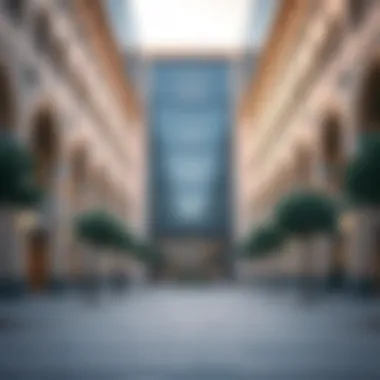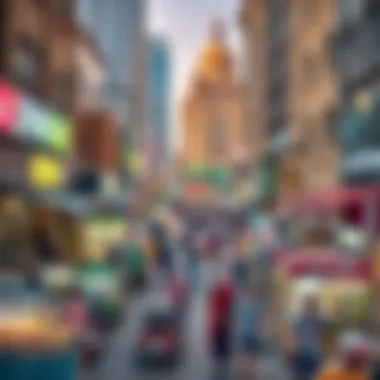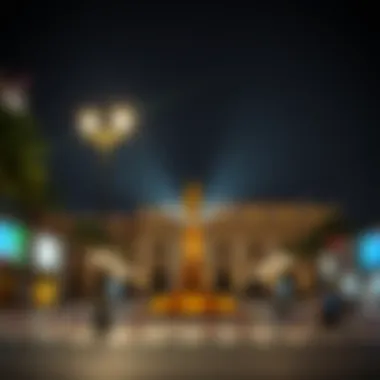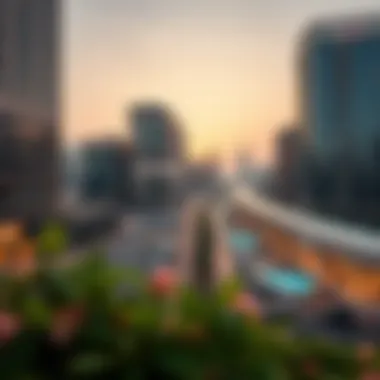Nasser Square: Exploring Dubai's Cultural and Economic Hub


Intro
Nasser Square is often described as the beating heart of Dubai. You stumble through its crowded streets and you can almost feel the pulse of the city, a blend of history, commerce, and cultural idiosyncrasies that tells the tale of an ever-evolving metropolis.
It's not just a geographical marker; it's a world unto itself where traditional souks coexist with modern shopping malls, and the aroma of spices dances with the scent of freshly brewed coffee. Drawing in tourists and residents alike, Nasser Square is a showcase of what Dubai has to offer – a bustling environment teeming with opportunities and experiences.
However, there’s more than meets the eye. As we delve into the historical context, architectural features, and economic significance of Nasser Square in this exploration, we will also be taking a closer look at how its urban environment shapes future developments.
We will unpack the current market trends, where opportunities lie for investors, and whether buying property here trumps renting. And for those curious about what the future holds – buckle up, because understanding Nasser Square is like piecing together a captivating puzzle of Dubai's dynamic landscape.
Historical Overview of Nasser Square
The historical significance of Nasser Square extends far beyond mere geography. It's a reflection of a changing landscape—both physically and culturally. Nestled in the heart of Dubai, this square has transformed from a modest junction to a bustling hub, serving as a magnet for various business and social activities. Its evolution is not just a tale of bricks and mortar; it is a narrative about identity, growth, and the spirit of a city that has made a name for itself on the global stage.
The Origins of Nasser Square
The roots of Nasser Square trace back to the early days of Dubai’s modernization. Originally, it was a simple intersection that connected several key roads in the area. The square got its name in honor of Sheikh Rashid bin Saeed Al Maktoum, who was instrumental in shaping modern Dubai. The transformation began in the mid-20th century when the city started to embrace industrialization and urbanization. Back then, it lay at the crossroads of trade—drawing merchants, travelers, and locals alike searching for their piece of prosperity in this burgeoning enclave.
Evolution Through Decades
As the years rolled by, Nasser Square began melting into the fabric of Dubai's expansive landscape. The 1970s saw a boom—a flurry of construction that brought with it shopping centers, hotels, and office buildings. People often liken the area to a beehive, buzzing with activity, with businesses pushing and tugging, all vying for a share of the economic action. Fast forward to the present day, and Nasser Square stands as a lively example of urban growth; it's woven with the stories of local businesses, diverse cultures, and the pulse of the city itself.
- The 1980s highlighted the rise of retail and commercial spaces, marking a significant shift.
- In the 1990s, infrastructural upgrades were introduced to accommodate an influx of tourists and expatriates.
- As of the 2000s, Nasser Square has continually evolved, integrating modern aesthetics while preserving its historical essence.
Cultural Significance in Dubai
Beyond serving as a commercial hub, Nasser Square holds substantial cultural importance. It is a microcosm of Dubai’s multifaceted society, where heritage and modernity coexist. This has given rise to various cultural events—from art fairs to traditional markets—that take place throughout the year. The square is seen as a melting pot of traditions, where local and expatriate communities converge, fostering a sense of belonging among its residents.
"Nasser Square embodies the vibrant spirit of Dubai. It's where tradition meets innovation, ceaselessly reshaping the cultural narrative of the city."
One might say that the essence of Nasser Square lies in its adaptability. It's a place where old world charm blends with cutting-edge development, making it indispensable to Dubai's identity. Understanding its history, cultural significance, and evolution through the decades lays the groundwork for a deeper appreciation of the economic and architectural narratives that will follow in the subsequent sections of this exploration.
Architectural Features of Nasser Square
The architectural features of Nasser Square are not just eye-candy; they are a tapestry that represents the blend of tradition and modernity in Dubai. This area reflects the city's quest for an iconic skyline through innovative design while grounded in cultural significance. The importance of these features cannot be overstated as they impact the urban landscape and, consequently, the economic viability of the square. Investors, homebuyers, and tourists are drawn to visually striking architecture, which, in turn, fuels the local economy.
Modern Design Influences
When discussing modern design influences in Nasser Square, it becomes clear that it is a microcosm of contemporary architectural trends. With buildings designed by renowned architects, many structures in this area showcase cutting-edge aesthetics. Take for instance the towering Al Ghurair Centre, which exemplifies how glass and steel can maximize light while creating a welcoming commercial space.
The use of sustainable materials and smart technology to enhance energy efficiency represents a leap into the future. These elements do not just define the skyline but also serve practical purposes.
- Sustainable Design: The emphasis on environmentally friendly materials.
- Smart Technologies: Integration of systems that enhance convenience and reduce energy consumption.
Additionally, the allure of open spaces adorned with greenery counterbalances the urban bustle, providing a moment of respite for residents and visitors alike. Nasser Square embodies a modern ethos, prioritizing not only aesthetics but also functionality.
Landmarks and Key Structures
Landmarks in Nasser Square serve as touchstones in the fabric of Dubai's community life. One cannot overlook the significance of Deira Clock Tower, a prominent structure that marks the square, standing as an enduring symbol of the area’s rich heritage. Its design fuses both historical and contemporary styles that reflect local culture.
Other notable landmarks include:


- Naif Souq: An example of traditional Arabian marketplace architecture, this structure hosts various shops, enhancing the commercial activity in the square.
- Dubai Police Headquarters: A striking blend of modern design with functional security features, showcasing a governmental presence that reinforces safety in the area.
These structures are not just for show; they encourage foot traffic, lending vibrancy to the locale. The architecture also facilitates various commercial activities, making Nasser Square an economic hotbed that draws investments and fosters community interactions.
"The architectural integrity of Nasser Square attracts both locals and visitors, encapsulating the spirit of Dubai’s evolution."
Investors and homebuyers are particularly keen on these dynamics, as the rich tapestry of architecture can dictate property values.
In summation, the architectural features of Nasser Square are a vital aspect of its identity. They not only enhance the visual landscape but also create functional spaces that contribute immensely to the social and economic fabric of the area. Having a clear understanding of this architectural significance is crucial for anyone looking to engage in the diverse opportunities this vibrant locale offers.
Economic Impact of Nasser Square
The economic significance of Nasser Square cannot be overstated. Situated at the heart of Dubai, it acts as a magnet for commercial activities and trade, which fuels the local economy. As a central hub, Nasser Square not only enhances the city's bustling business environment but also reflects the rapid urban growth that Dubai has experienced. This section examines various facets of its economic impact, focusing on aspects like commercial activity, real estate trends, and investment opportunities.
Commercial Activity Analysis
Nasser Square thrives with a myriad of commercial establishments, ranging from high-end retail stores to small family-run businesses. The area is bustling with visitors and residents alike, contributing to a lively atmosphere that fosters economic growth. The square serves as a key intersection for transportation networks, making it easily accessible for both consumers and suppliers.
One of the standout features of the area is its diverse range of shops, which cater to both luxury consumers and those seeking more practical purchases. Businesses here include established brands like Carrefour and local favorites such as Al Mufeed. The competition among businesses tends to keep prices in check while also promoting customer service excellence, ensuring that businesses must continually raise their standards to attract consumers.
This environment cultivates a strong sense of community while supporting local entrepreneurship, which is crucial in maintaining economic stability.
Real Estate Trends in the Area
Real estate around Nasser Square has experienced noteworthy fluctuations in recent years. As demand has surged for both residential and commercial properties, prices have risen in tandem. Investors keep a keen eye on the market, particularly since the square is adjacent to some of the most flourishing districts in Dubai.
Developers are actively engaging in new projects, often favoring mixed-use developments that combine residential, commercial, and leisure spaces. The resulting urban designs not only offer potential buyers convenience but also aim to create a vibrant atmosphere that encourages foot traffic. Properties like the Al Ghurair Centre represent just one example of how the area has evolved to meet the needs of residents and investors alike.
Some trends observed include:
- Increased rental yields: With the influx of expatriates and professionals, rental properties are in high demand.
- High occupancy rates: Businesses are consistently filling spaces in the area, further enhancing its commercial viability.
Investment Potential and Opportunities
Nasser Square presents a dynamic environment that appeals to prospective investors. With the ongoing development projects and the continuation of economic growth in Dubai, the square stands as an attractive option. The local government’s commitment to enhancing urban infrastructure elevates its status even further as a premier investment destination.
Potential investors can consider various options:
- Retail spaces: Given the dual appeal of tourist and residents, retail opportunities can yield high returns.
- Office spaces: The demand is on the rise for flexible office solutions as remote work takes a new shape; thus, investing in commercial office expansions may offer lucrative returns.
- Hospitality: With tourism flourishing in Dubai, investing in accommodation or mixed-use developments that include hotel services may prove beneficial.
In summary, Nasser Square’s economic impact is multi-faceted, extending beyond mere commerce. Its continual evolution and adaptability signal promising trends for investors and stakeholders, making it a focal point in Dubai's economic landscape.
Transportation and Accessibility
Transportation and accessibility are pivotal elements in the broader discussion of Nasser Square. This area serves not only as a commercial hub but also as a crucial intersection connecting various parts of Dubai. A comprehensive understanding of its transport infrastructure greatly informs potential investors, homebuyers, and renters about the value of properties in the vicinity.
Public Transport Infrastructure
The public transport network around Nasser Square is near state-of-the-art. The square is adjacent to several essential transit nodes that facilitate easy movement throughout the region. Notably, the Dubai Metro has stations located conveniently nearby, ensuring that commuters can access major commercial and residential areas effortlessly.
Moreover, buses frequently thread through the area, providing widespread connectivity. This extensive transit system allows residents and visitors alike to navigate Dubai without the dependence on personal vehicles, which translates into lower transportation costs. By streamlining access to and from Nasser Square, the effective public transport infrastructure boosts foot traffic to local businesses.


Benefits of Accessibility
- Convenience for daily commutes
- Increased foot traffic supporting local shops and services
- Reduced reliance on private vehicles, lowering overall traffic congestion
In addition to the Metro and bus services, there are provisions for taxis and ride-sharing services, making it easier for tourists and business professionals to reach their destinations with minimal hassle. This seamless transportation access solidifies Nasser Square as a prime location for businesses seeking to attract a diverse clientele, reinforcing the area's bustling commercial identity.
Impact on Property Values
The transportation accessibility directly impacts property values in and around Nasser Square. With easy transit options, properties in this area tend to command higher prices. Investors looking to tap into the Dubai real estate market will find that the demand remains robust due to the enhanced connectivity of Nasser Square.
Research has indicated that properties situated near efficient public transport links often see appreciation values at a higher rate compared to their counterparts in less accessible areas. The availability of transport options not only attracts businesses but also appeals to potential residents who prioritize convenience.
"A well-connected area typically sees not just an increase in property values but also a vibrant community atmosphere, making it a prime target for those looking to invest their money wisely."
In summary, accessibility through public transport is fundamental in shaping the economic landscape of Nasser Square. It enhances property desirability, leads to increased rental yields, and ultimately contributes to a thriving community. Both investors and homebuyers must keep this in mind when assessing opportunities in the marketplace.
Urban Development Planning
Urban development planning plays a crucial role in determining the future trajectory of Nasser Square. This area, which serves as a vibrant hub for commerce and culture in Dubai, requires continuous assessment and strategic planning to ensure it meets the evolving needs of its community while maintaining its economic viability. The essence of effective urban development lies in balancing growth, sustainability, and aesthetics, which are particularly significant in a modern city like Dubai.
One of the most salient benefits of urban development planning is the enhancement of infrastructure. As Nasser Square increasingly attracts businesses and residents alike, the need for high-quality public amenities becomes paramount. This includes improving transportation systems—such as roads and public transit—which can alleviate congestion and facilitate easy access to different parts of the city. Moreover, embracing smart city technologies can lead to more efficient resource management that benefits both residents and businesses.
Considerations around land use are equally relevant. Planning decisions about commercial versus residential space directly impact community dynamics. Striking the right balance ensures that there’s enough housing for newcomers and sufficient commercial space to support local economies. Such zoning laws should reflect the unique demographic composition of Nasser Square, encouraging diverse demographics to move into the area.
"The future success of any urban area lies in its planning. The right choices today can set the course for a thriving community in the years to come."
In the heart of urban development planning, sustainability initiatives have gained momentum. This shift is not merely a trend, but a necessity dictated by environmental concerns and the pressing need for sustainable living practices. Local policymakers have an obligation to prioritize green spaces and promote energy-efficient buildings while adapting to the challenges of climate change.
Future Development Projects
Anticipated future development projects around Nasser Square focus on enhancing the area's appeal to investors, residents, and tourists alike. Various constructions such as mixed-use developments are on the horizon. These will combine residential, commercial, and recreational spaces into one cohesive unit. The integration of parks and public spaces not only creates a balanced urban environment but also enriches the community's quality of life.
One significant proposal includes the expansion of the metro system to incorporate Nasser Square more effectively, connecting it seamlessly to other key areas of Dubai. This would not just make commuting easier for residents but also increase foot traffic for businesses in the vicinity. Additionally, incorporating more pedestrian-friendly pathways can encourage walking and cycling, thus supporting the overall goal of a more sustainable urban environment.
Sustainability Initiatives
The shift towards sustainability within urban development planning is increasingly critical. Sustainability initiatives in Nasser Square focus on reducing the ecological footprint through smart design and technology. New buildings are encouraged to adopt energy-efficient systems, utilize renewable energy sources, and incorporate green roofs. These features not only reduce operational costs but also contribute to the overall health of the urban ecosystem.
Moreover, local governments are incentivizing businesses to focus on sustainable practices such as waste reduction and water conservation. Community engagement in sustainability programs fosters a sense of responsibility and involvement among residents, amplifying the impact of these initiatives.
In essence, urban development planning is far more than just erecting new buildings; it’s a comprehensive approach that infuses life into a community. With Nasser Square at the epicenter of Dubai's bustling life, its future development must cater to both current needs and those of the generations to come. Prioritizing these planning considerations will ensure that the square remains a well-rounded destination for commerce, culture, and community for years ahead.
Community Dynamics Around Nasser Square
Exploring the community dynamics around Nasser Square reveals a rich tapestry of interactions and relations that define the area. Understanding these dynamics is crucial, especially for potential investors, homebuyers, renters, and those with a keen eye on real estate trends. The blend of demographic diversity and vibrant social activities creates a unique atmosphere, contributing to Nasser Square's identity as a bustling hub in Dubai.
Demographics of Residents
The demographic make-up of Nasser Square is a melting pot that reflects the broader population of Dubai. It hosts a medley of nationalities, ages, and backgrounds.
- Expatriates dominate the scene, with people from South Asia, the Middle East, Europe, and beyond, who flock to the area for its commercial opportunities. This diverse population brings a kaleidoscope of cultures, influencing social interactions and local customs.
- Families, young professionals, and retirees all find their place within this vibrant community. The presence of varied age groups contributes to a myriad of social settings, from lively marketplaces to tranquil parks, where families can enjoy leisure time.
- It’s also worth noting that the local housing market has adapted to this diversity. For instance, there are numerous apartment complexes catering to different income brackets, making it affordable for many to live close to their workplaces.


Social and Cultural Activities
Nasser Square vibrates with social and cultural activities, knitting the community closer together:
- Cultural Festivals: The square often hosts cultural festivals highlighting Dubai's rich heritage, featuring music, dance, and art displays. These events foster community spirit and encourage participation from residents, enhancing social bonds.
- Public Markets: Apart from major commercial entities, lively street markets pop up, offering local products, crafts, and culinary delights. These markets not only provide entertainment but also serve as a platform for local entrepreneurs, encouraging small businesses.
- Community Centers: Several community centers in the vicinity have become hot spots for workshops, sports programs, and art classes. These centers cater to all ages, promoting lifelong learning and engagement across generations.
"The community around Nasser Square is not just about living spaces; it's a vibrant ecosystem where interactions flourish, significantly impacting property desirability and investment potential."
Challenges Faced by Nasser Square
The rapid development and urbanization of Nasser Square have brought about a series of challenges that need understanding and addressing. This section explores the intricate issues confronting this pivotal area, emphasizing the implications for investors, homebuyers, and urban planners. The metropolitan landscape of Dubai thrives on its dynamic properties, but within that vitality lies an undercurrent of hurdles that affect not just the day-to-day workings of Nasser Square but its long-term viability.
Urban Congestion Issues
Urban congestion presents a substantial issue for Nasser Square, straining both its infrastructure and the quality of life for those who reside and work in the vicinity. The square is a bustling hub, and with increasing foot traffic comes the inevitable gridlock. For instance, during peak hours, narrow roads often become bottlenecks, making transportation a frustrating affair.
The intersection of various transport lines—buses, taxis, and the metro—adds to the congestion complexity. Although significant efforts have been made to improve transport infrastructure, the sheer volume of vehicles and pedestrians can create chaos. It’s not just about getting from point A to B; the experience can be downright exasperating.
- Factors contributing to congestion include:
- High population density around Nasser Square.
- A surge in commercial establishments attracting visitors.
- Limited alternative routes forcing traffic into a few key passageways.
The management of this congestion is not just about improving roads or transit options. Stakeholders must consider how these issues could scare away potential investors or deter buyers who may prefer less-frantic locales. It’s a tightrope walk, trying to balance development while ensuring that daily life remains manageable for everyone involved.
Environmental Concerns
Another pressing difficulty for Nasser Square pertains to environmental concerns, which overlap significantly with urban congestion issues. The environmental impact of excessive traffic is profound—air and noise pollution can transform a vibrant square into an unpleasant experience.
For example, research by local environmental agencies has indicated that increased vehicular emissions lead to higher levels of respiratory illnesses among nearby residents. With the sprawling buildings that characterize Nasser Square, the situation can become even more critical.
- Notable environmental issues include:
- Elevated levels of air pollution due to high traffic volume.
- Insufficient green spaces providing relief from urban heat.
- Strain on local resources, such as water and energy, driven by expanding commercial activities.
Addressing these environmental challenges demands more than mere policies; it necessitates a communal commitment towards sustainability. Initiatives such as developing green corridors or introducing stricter emissions regulations could potentially mitigate some adverse effects. The hope is to foster an ecosystem that is not only economically viable but also environmentally sustainable, striking a balance between progress and preservation.
"The future of Nasser Square hinges on our ability to reconcile the demands of urban life with the preservation of our environment. Striking that balance is critical for sustained success."
Culmination: The Future of Nasser Square
In wrapping up our exploration of Nasser Square, it's vital to underscore its evolving role within Dubai's urban landscape. As a hub of commercial activity and cultural significance, the future of Nasser Square carries weight for various stakeholders. The intersection of commerce, community, and culture creates a melting pot of opportunities. Investors, homebuyers, renters, agents, and managers all have a vested interest in what lies ahead here.
Long-term Predictions
Looking ahead, several trends emerge that could shape Nasser Square in the coming years. The continued expansion of Dubai's infrastructure, particularly with the Dubai Metro and roads, suggests a better connected Square. As more businesses flock to this area, it can expect a rise in foot traffic, enhancing both the commercial potential and livability.
Moreover, urbanization is likely to increase density around Nasser Square. With the city’s ongoing push for sustainable and smart development, structures may incorporate eco-friendly technologies. These shifts will not only attract more residents but also elevate property values slightly as demand spikes against available inventory.
- Continued infrastructure growth
- Increased urban density
- Focus on sustainability
Key Takeaways for Investors
For anyone considering investment in Nasser Square, knowledge is power. Here are some crucial factors to keep in mind:
- Market Timing: As the area reinvents itself, the upcoming years present a prime window for investments before property prices rise significantly.
- Diverse Opportunities: From residential to commercial properties, there’s a potpourri of choices. Investors can benefit from approaching the market with a multi-faceted strategy.
- Community Development: Understanding the demographic changes and community needs will help forecast which areas show promise for appreciation.
In summary, Nasser Square's journey is far from over. Its future could very well be a cycle of continual growth, innovation, and cultural enrichment. Keeping a pulse on these currents will not only inform investments but also build pathways for a thriving community.







